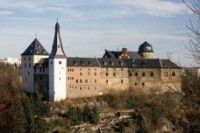The object, known as Ekori is a sacred part of the Ovaherero pre-colonial women’s clothing, worn as a type of hair dressing. The bunch or iron-bead strings are the shoulder-length Ekori extensions worn at the back of the head. Ekori is made of iron beads and animal skin usually derived from game animals of Namibian origin, and supplemented by the animal skin of domestic animals in pastoral communities like the Herero. It is so crafted to seem like and symbolise the horns of a cow, which is an economically and spiritually iconic animal in the Hereroland, e.g. the cow was the Herero’s main source of wealth and sustenance. However, the 19th century missionaries considered the cow horns symbolism as devilish and rejected it, thereby causing the people to people to switch the material from which Ekori was made, from animal to fabric; hence, its current name, Otjikaiva “headgear made from fabric”. Basically, Ekori was worn by married women, and held in place by a head band studded with iron beads. Ekori was a solemnity of matrimony object. At weddings the bride was solemnly crowned with an Ekori and a woman’s bonnet by her mother (Lang, 2022) as a sign of her new status: adult and married. Ekori is worn above leather women’s bonnets like those exhibited under the inventory numbers V 15168 N 02 & V 15169 N 02 as part of the adult womanhood attire, alongside shin ornamental bands such as those exhibited under inventory numbers 60558 and 60559.
de





